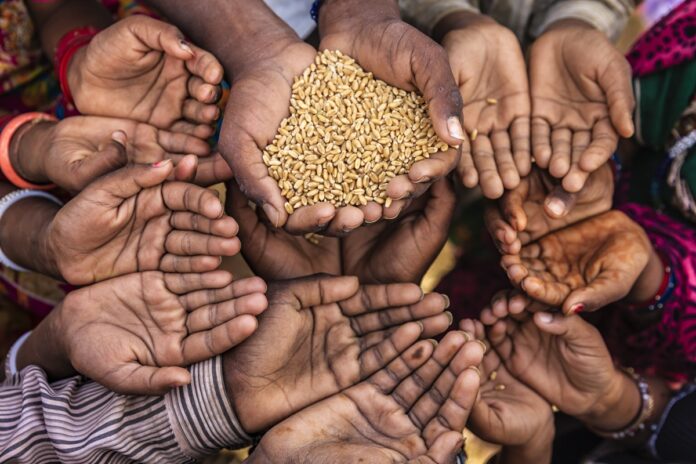The 2024 Global Hunger Index (GHI) reveals alarming statistics about India’s ongoing struggle with hunger and malnutrition, ranking the country in the “serious” category, 105th out of 127 nations. The GHI, a widely recognized measure developed by Concern Worldwide and Welthungerhilfe, serves as a crucial tool for tracking hunger and undernutrition across the globe. India’s GHI score of 27.3 reflects the severe challenges the nation faces in ensuring food security and tackling child malnutrition and mortality.
The Disturbing Numbers Behind India’s Hunger Crisis
The GHI score is derived from four key indicators: undernourishment, child stunting, child wasting, and child mortality. Each of these metrics highlights the deep-rooted problems India faces in combating hunger.
- Undernourishment: Approximately 13.7% of India’s population lacks sufficient caloric intake, which is a significant indicator of widespread food insecurity.
- Child Stunting: A staggering 35.5% of children under five years old suffer from stunting. Stunting is a clear indication of chronic undernutrition, which affects both physical and cognitive development.
- Child Wasting: Around 18.7% of children under five are affected by wasting, meaning they have low weight for their height. This metric reflects acute malnutrition and the immediate risk of severe health consequences for millions of Indian children.
- Child Mortality: The child mortality rate stands at 2.9%, meaning nearly 3 out of every 100 children in India do not live past their fifth birthday. This high mortality rate, linked to malnutrition, indicates the severe impact of hunger on the most vulnerable section of society.
These figures are not just numbers; they reflect the daily struggles of millions of Indian families. The prevalence of undernourishment, along with the high rates of stunting and wasting, presents a complex challenge that demands urgent and sustained intervention from both the government and civil society.
India’s Position in Global Context
India is not alone in grappling with hunger. However, its ranking at 105th places it among 42 countries categorized as having “serious” levels of hunger. Countries such as Pakistan and Afghanistan share this category, though some of India’s South Asian neighbors, like Bangladesh, Nepal, and Sri Lanka, have fared better, ranking in the “moderate” hunger category. This comparison underscores the need for India to intensify its efforts to combat hunger and improve nutritional outcomes, especially when nearby countries are showing signs of improvement.
India’s struggles also reflect broader global trends. As of 2024, 733 million people worldwide are estimated to experience hunger on a daily basis, and an astonishing 2.8 billion cannot afford a healthy diet. The food crisis is not only a challenge of food distribution but also of affordability and accessibility, and this has been exacerbated by global issues such as armed conflicts and climate change. Wars in regions like Gaza and Sudan have triggered extreme food shortages, while protracted crises in places like the Democratic Republic of the Congo and Syria continue to aggravate food insecurity.
Key Challenges to Achieving Zero Hunger
The United Nations Sustainable Development Goal (SDG) of Zero Hunger by 2030 now seems increasingly out of reach for many nations, including India. A combination of domestic issues, such as poverty, population growth, and inefficient food distribution systems, as well as external factors like climate change and global conflicts, is stalling progress. Climate change, in particular, poses a long-term threat, with rising temperatures and erratic weather patterns negatively impacting agriculture and food production. Meanwhile, global political instability has diverted attention and resources from addressing food insecurity.
India’s path to eliminating hunger is further complicated by socioeconomic disparities. Malnutrition is often worse in poorer states and rural regions, where access to food and healthcare remains limited. Social inequalities also play a role, as marginalized communities, including women and children, are disproportionately affected by hunger and undernutrition.
Steps Toward a Hunger-Free India
To combat hunger effectively, India must adopt a holistic approach that addresses the root causes of food insecurity. Government programs aimed at poverty alleviation, improving agricultural productivity, and ensuring food distribution must be reinforced with targeted nutrition interventions for vulnerable populations, particularly women and children.
- Strengthening Food Security Programs: Existing food security initiatives such as the Public Distribution System (PDS) need to be improved for better coverage and efficiency. The focus should also be on ensuring that nutritious food reaches those who need it most.
- Agricultural Reforms: Improving agricultural productivity through sustainable practices and technological innovation can help mitigate the impact of climate change on food production. Supporting small-scale farmers and promoting crop diversification are critical components of a long-term solution.
- Enhancing Child Nutrition Programs: Programs like the Integrated Child Development Services (ICDS) and the Mid-Day Meal Scheme must be scaled up and made more efficient to reach children in the most vulnerable areas. Regular monitoring and evaluation of these programs are essential to ensure they are having the intended impact.
- Addressing Gender Inequality: Hunger and malnutrition disproportionately affect women, especially pregnant and lactating mothers. Empowering women through education, better healthcare access, and economic opportunities can have a transformative effect on improving the nutritional outcomes of entire families.
The Road Ahead
India’s ranking in the 2024 GHI report highlights the urgency of its hunger crisis. While the challenges are immense, the solution requires concerted efforts from all sectors of society, including the government, private sector, non-governmental organizations, and international partners. India must commit to innovative solutions that address not only immediate food needs but also the long-term structural issues contributing to hunger and malnutrition.
By taking these steps, India can hope to improve its GHI ranking in the future, but more importantly, it can work toward the ultimate goal of ensuring that no Indian goes hungry. Only through coordinated, sustained efforts can the dream of a hunger-free India become a reality, moving the nation closer to achieving the global objective of Zero Hunger by 2030.

